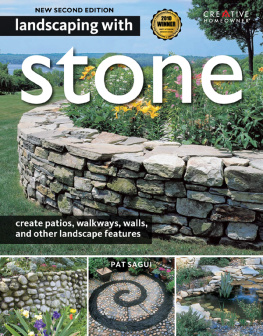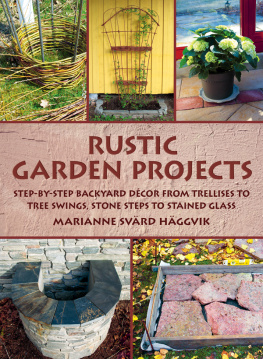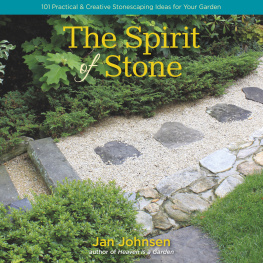Contents
Guide



ACKNOWLEDGMENTS
Masons, landscape architects, designers, sculptors, and homeowners graciously contributed projects and their hard-earned experience to this book. I am deeply indebted and grateful to them. I am also indebted to the landscape architects and educators whose books inspired and helped me distill a vast body of know-how into a how-to primer. To Managing Editor Fran Donegan, who came on the scene after the manuscript was complete, my sincere appreciation for his patience with a first-time author. Special thanks to Charlie Proutt and Danny Young for reading the manuscript and making suggestions to improve it; to Miranda Smith for her tutelage; and to Brian and Will for their good humor and understanding, without which I could not take on projects that add unimagined wanderings to our life.
SAFETY FIRST
All projects and procedures in this book have been reviewed for safety; still it is not possible to overstate the importance of working carefully. What follows are reminders for plant care and project safety. Always use common sense.
Always use caution, care, and good judgment when following the procedures in this book.
Always determine locations of underground utility lines before you dig, and then avoid them by a safe distance. Buried lines may be for gas, electricity, communications, or water. Contact local utility companies who will help you map their lines.
Always read and heed tool manufacturer instructions.
Always ensure that the electrical setup is safe; be sure that no circuit is overloaded and that all power tools and electrical outlets are properly grounded and protected by a ground-fault circuit interrupter (GCFI). Do not use power tools in wet locations.
Always wear eye protection when using chemicals, sawing wood, pruning trees and shrubs, using power tools, and striking metal onto metal or concrete.
Always consider nontoxic and least toxic methods of addressing unwanted plants, plant pests, and plant diseases before resorting to toxic methods. Follow package application and safety instructions carefully.
Always read labels on chemicals, solvents, and other products; provide ventilation; heed warnings.
Always wear a hard hat when working in situations with potential for injury from falling tree limbs.
Always wear appropriate gloves in situations in which your hands could be injured by rough surfaces, sharp edges, thorns, or poisonous plants.
Always protect yourself against ticks, which can carry Lyme disease. Wear light-colored, long-sleeved shirts and pants. Inspect yourself for ticks after every session in the garden.
Always wear a disposable face mask or a special filtering respirator when creating sawdust or working with toxic gardening substances.
Always keep your hands and other body parts away from the business end of blades, cutters, and bits.
Always obtain approval from local building officials before undertaking construction of permanent structures.
Never employ herbicides, pesticides, or toxic chemicals unless you have determined with certainty that they were developed for the specific problem you hope to remedy.
Never allow bystanders to approach work areas where they might by injured by workers or work site hazards.
Never work with power tools when you are tired, or under the influence of alcohol or drugs.
Never carry sharp or pointed tools, such as knives or saws, in your pocket.
CONTENTS
CHAPTER 1
DESIGNING WITH STONE

CHAPTER 2
PLANNING YOUR PROJECT
CHAPTER 3
STONE AS A BUILDING MATERIAL
CHAPTER 4
TOOLS & TECHNIQUES
CHAPTER 5
PATHS & WALKWAYS
CHAPTER 6
STONE PATIOS
CHAPTER 7
LANDSCAPE STEPS
CHAPTER 8
STONE & WATER FEATURES
CHAPTER 9
SETTING LARGE STONES
CHAPTER 10
ROCK GARDENS
CHAPTER 11
FREESTANDING WALLS
CHAPTER 12
RETAINING WALLS

INTRODUCTION
THIS BOOK IS FOR THE HOMEOWNER who wants to include natural stone in his or her landscape design. More than ever before, the availability of different types of stone and the ease of renting stone-moving equipment make ambitious projects possibleeven for homeowners who have no experience working with stone as a landscaping material.
Stone can be used to great effect in all landscapes. For thousands of years, it has served our needs and our fancy. Craftsmen have quarried, hauled, stacked, shaped, laid, mortared, set, shimmed, and carved stone with a breadth of craft and ingenuity that is both awe inspiring and humbling. Those projects are an inspiration to all homeowners who want to include stonework in their designs.

Stone pavers set in a star pattern surround a tree on this backyard patio.

Mortared flagstone steps lead up to rustic wood doors at this California homes entryway.
Good stonework takes both physical and creative energy. It also takes the skills and procedures common to all successful projects: realistic expectations, reliable suppliers and subcontractors, good record keeping, patience, and an appreciation for sweat equity. At roughly 160 pounds to the cubic foot, stonework will test your mettle.
Landscaping with Stone can take the guesswork out of your project. Use the information to complete a project on your own, or rely on it for guidance when collaborating with a mason or designer.
Design and Planning
The first four chapters help you think of stone as a landscaping element. Use them to guide you through defining the overall style of a project, evaluating the site, choosing the stone, and coordinating an installation. A chapter on tools and techniques will introduce you to some of the tools that could make your project go more smoothly. The plan presented in these chapters helps you stay organized, keep your momentum, and make the best use of your resources.
Stone Projects
Chapters 5 through 12 each look at a specific stonework project. These chapters feature the voices of experiencehomeowners, designers, landscapers, and masons who generously contributed information for this book. Their projects are from geographic areas of the U.S. where natural stone is plentiful and there is a tradition of using stone in gardens and landscapes. Each chapter includes design information, dozens of photographs of stonework projects, and installation guidance.

















